LGBT symbols
| Part of a series on |
| Lesbian, gay, bisexual, and transgender (LGBT) people |
|---|
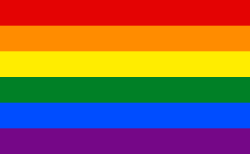 |
| Sexual orientation |
| History |
| Culture |
| Rights |
| Social attitudes |
| Prejudice / Violence |
|
Academic fields and discourse |
|
|
The LGBT community has adopted certain symbols for self-identification which demonstrate unity, pride, shared values, and allegiance to one another. LGBTQ symbols communicate ideas, concepts, and identity both within their communities and to mainstream culture. The two most-recognized international LGBTQ symbols are the pink triangle and the rainbow flag. The pink triangle, employed by the Nazis in World War II as a badge of shame, was re-appropriated but retained negative connotations. The rainbow flag, previously used as a symbol of unity between all people, was adopted to be a more organic and natural replacement without any negativity attached to it.
Triangles used for persecution during the Nazi regime
| LGBT symbols | ||||||||
|---|---|---|---|---|---|---|---|---|
|
|
||||||||
One of the oldest of these symbols is the pink triangle, which originated from the Nazi concentration camp badges that male homosexuals were required to wear on their clothing.[1] Many of the estimated 5–15,000 gay men and lesbian women imprisoned in concentration camps died during the Holocaust.[2] For this reason, the pink triangle is used as an identification symbol and as a memento to remind both its wearers and the general public of the atrocities that gays suffered under Nazi persecutors. AIDS Coalition to Unleash Power (ACT-UP) adopted the inverted pink triangle to symbolize the "active fight back" against HIV/AIDS "rather than a passive resignation to fate."
The pink triangle was used exclusively with male prisoners—lesbians were not included under Paragraph 175, a statute which made homosexual acts between males a crime. The United States Holocaust Memorial Museum stipulates that this is because women were seen as subordinate to men, and that the Nazi state feared lesbians less than gay men. However, the USHMM also claims that many women were arrested and imprisoned for "asocial" behaviour, a label which was applied to women who did not conform to the ideal Nazi image of a woman: cooking, cleaning, kitchen work, child raising, and passivity. These women were labeled with a black triangle.[3] Lesbians reclaimed this symbol for themselves as gay men reclaimed the pink triangle.
| Pink Triangle | Black Triangle | Pink & Yellow Triangles |
|---|---|---|
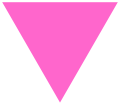 |
 |
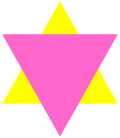 |
| The pink triangle was originally used to denote homosexual men as a Nazi concentration camp badge. | The black triangle was used to mark "asocial" and "workshy" individuals, including lesbians, Romani and others in the camps. It has been adapted as a lesbian symbol. | The pink triangle overlapping a yellow triangle was used to tag Jewish homosexuals in Nazi concentration camps. |
Labrys

The labrys, or double-bladed battle axe, was a symbol used in the ancient civilization of Minoan Crete (sometimes portrayed as having certain matriarchal tendencies). Today it is used to represent lesbian and feminist strength and self-sufficiency.[4] It has been in use since the late 1970s. Some lesbians have it tattooed on their inner wrist while others wear it as a pendant.[5]
Lambda

In the early 1970s, graphic designer Tom Doerr selected the Greek letter lambda to be the symbol of the New York chapter of the Gay Activists Alliance.[6] The alliance's literature states that Doerr chose the symbol specifically for its denotative meaning in the context of chemistry and physics: “a complete exchange of energy--that moment or span of time witness to absolute activity".[6] Within the STEM field, the lambda symbol is associated with the half-life parameter of exponential random variables, which describes the time it takes for a state to change.
In December 1974, the lambda was officially declared the international symbol for gay and lesbian rights by the International Gay Rights Congress in Edinburgh, Scotland.[7] The gay rights organization Lambda Legal and the American Lambda Literary Foundation derive their names from this symbol.
Purple hand
On 31 October 1969, sixty members of the Gay Liberation Front (GLF) and the Society for Individual Rights (SIR) staged a protest outside the offices of the San Francisco Examiner in response to another in a series of news articles disparaging LGBT people in San Francisco's gay bars and clubs.[8][9] The peaceful protest against the "homophobic editorial policies" of the Examiner turned tumultuous and were later called "Friday of the Purple Hand" and "Bloody Friday of the Purple Hand".[9][10][11][12][13] Examiner employees "dumped a bag of printers' ink from the third story window of the newspaper building onto the crowd".[9][11] Some reports state that it was a barrel of ink poured from the roof of the building.[14] The protesters "used the ink to scrawl 'Gay Power' and other slogans on the building walls" and stamp purple hand prints "throughout downtown San Francisco" resulting in "one of the most visible demonstrations of gay power".[9][11][13] According to Larry LittleJohn, then president of SIR, "At that point, the tactical squad arrived – not to get the employees who dumped the ink, but to arrest the demonstrators. Somebody could have been hurt if that ink had gotten into their eyes, but the police were knocking people to the ground."[9] The accounts of police brutality include women being thrown to the ground and protesters' teeth being knocked out.[9][15]
Inspired by Black Hand extortion methods of Camorra gangsters and the Mafia,[16] some gay and lesbian activists attempted to institute "purple hand" as a warning to stop anti-gay attacks, with little success. In Turkey, the LGBT rights organization MorEl Eskişehir LGBTT Oluşumu (Purple Hand Eskişehir LGBT Formation), also bears the name of this symbol.[17]
Pride flag and colors
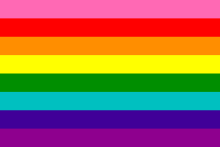
Original eight-stripe version designed by Gilbert Baker in 1978

Version with hot pink removed due to fabric unavailability. (1978–1979)

Six-color version popular since 1979. Yet another stripe is reduced to have an even number, as to prevent middle colors from being hidden when hung vertically on lampposts. Indigo is interchangeable with a royal or navy blue in this version.
Rainbow flag
Gilbert Baker designed the rainbow flag for the 1978 San Francisco Gay Freedom Celebration. The flag does not depict an actual rainbow. Rather, the colors of the rainbow are displayed as horizontal stripes, with red at the top and violet at the bottom. It represents the diversity of gays and lesbians around the world. In the original eight-color version, pink stood for sexuality, red for life, orange for healing, yellow for the sun, green for nature, turquoise for art, indigo for harmony, and violet for the soul.[18] The original eight-color rainbow flag flies over the Castro in San Francisco and from the Lesbian, Gay, Bisexual, and Transgender Community Center in New York City.

Freedom rings
Freedom rings, designed by David Spada, are six aluminum rings, each in one of the colors of the rainbow flag. They were released in 1991.[19] Symbolizing happiness and diversity, these rings are worn by themselves or as part of necklaces, bracelets, and key chains.[19] They are sometimes referred to as "Fruit Loops".[20]
Pansexuality

The pansexual pride flag has been found on various Internet sites since mid-2010.[21] It has three horizontal bars that are pink, yellow and blue.[22] The pink band symbolizes women, the blue men, and the yellow those of a non-binary gender, such as agender, bigender or genderfluid.[21][23][24][25][26]
Gender symbols

Modifications of the classical gender symbols (based on astrological symbols, Mars for male and Venus for female) have appeared to express various LBGT gender identities since the 1990s. Two interlocking male symbols form a gay male symbol. Two interlocking female symbols form a lesbian symbol.
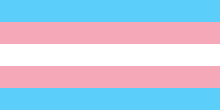
A transgender symbol is the Transgender Pride flag designed by transgender woman Monica Helms in 1999[27] and was first shown at a pride parade in Phoenix, Arizona, USA in 2000.[28] It was flown from a large public flagpole in San Francisco's Castro District beginning November 19, 2012 in commemoration of the Transgender Day of Remembrance.[28] The flag represents the transgender community and consists of five horizontal stripes: two light blue, two pink, with a white stripe in the center. Helms described the meaning of the flag as follows:
| “ | The stripes at the top and bottom are light blue, the traditional color for baby boys. The stripes next to them are pink, the traditional color for baby girls. The stripe in the middle is white, for those who are intersex, transitioning or consider themselves having a neutral or undefined gender. The pattern is such that no matter which way you fly it, it is always correct, signifying us finding correctness in our lives.[28] | ” |
Santa Clara County became the first county government in the U.S. to raise the transgender pride flag in 2016.[29]
Also under the trans or transgender umbrella are all those who identify off the gender binary. There are many different identities within this category including genderqueer, two-spirit, gender fluid, third gender, and androgyny.[30]
Intersex

Intersex people are those who do not exhibit all the biological characteristics of male or female, or exhibit a combination of characteristics, at birth. They are estimated by some to be about 1% of the population.[31]
The Intersex flag was created by Organisation Intersex International Australia in July 2013 to create a flag "that is not derivative, but is yet firmly grounded in meaning". The organisation aimed to create a symbol without gendered pink and blue colors. It describes yellow and purple as the "hermaphrodite" colors. The organisation describes it as freely available "for use by any intersex person or organisation who wishes to use it, in a human rights affirming community context".[32][33][34]
Bear culture


Bear is an affectionate gay slang term for those in the bear communities, a subculture in the gay community and an emerging subset of the LGBT community with its own events, codes, and culture-specific identity. Bears tend to have hairy bodies and facial hair; some are heavy-set; some project an image of working-class masculinity in their grooming and appearance, though none of these are requirements or unique indicators. The bear concept can function as an identity, an affiliation, and an ideal to live up to. There is ongoing debate in bear communities about what constitutes a bear. Some state that self-identifying as a bear is the only requirement, while others argue that bears must have certain physical characteristics, such as a hairy chest and face, a large body, or a certain mode of dress and behavior.
Bears are almost always gay or bisexual men; transgender men (regardless of their sexuality) and those who shun labels for gender and sexuality are increasingly included within bear communities. The bear community has spread all over the world, with bear clubs in many countries. Bear clubs often serve as social and sexual networks for older, hairier, sometimes heavier gay and bisexual men, and members often contribute to their local gay communities through fundraising and other functions. Bear events are common in heavily gay communities.
The International Bear Brotherhood Flag was designed in 1995 by Craig Byrnes.[35]
Butch and femme
The website Butch-Femme.com uses a black triangle in a red circle to represent butch–femme sexuality.[36]
Asexuality

In August 2010, after a process of getting the word out beyond the Asexual Visibility and Education Network (AVEN)[37] and to non-English speaking areas, a flag was chosen[38] following a vote on a non-AVEN site.[39] It has since been seen used on Tumblr in various LGBTQ areas, but had been seen alongside other Sexual Orientations flags previous to formal election.[40] The black stripe represents asexuality, the grey stripe the grey-area between sexual and asexual, the white stripe sexuality, and the purple stripe community. The AVEN logo is a triangle fading from white to black to symbolise the gradient between sexuals, gray-asexuals, demisexuals and asexuals. The ace of spades and ace of hearts are also used as asexual symbols since "ace" is a phonetic shortening of asexual. Generally, romantic asexuals use the ace of hearts as their symbol and aromantic asexuals use the ace of spades.[41]
Other symbols
In addition to major symbols of the LGBT community, less-popular symbols have been used to represent members’ unity, pride, shared values, and allegiance to one another.

In ancient Rome, as in 19th-century England, green indicated homosexual affiliations. Victorian men would often pin a green carnation on their lapel as popularized by author Oscar Wilde, who often wore one on his lapel.[42]

According to some interpretations, American poet Walt Whitman used the calamus plant to represent homoerotic love.[43]

Bisexual women and lesbians used to give violets to the woman they were wooing, symbolizing their "Sapphic" desire. In a poem, Sappho described herself and a lover wearing garlands of violets. The giving of violets was popular from the 1910s to the 1950s.[44]
- In the Society for Creative Anachronism, LGBT members often wear a blue feather to indicate an affiliation with Clan Blue Feather, a group of SCA members promoting the study of LGBT culture and people in the Middle Ages.
- In the United Kingdom, since 2006 the Pink Jack has been widely used to represent a uniquely British LGBT identity.[45][46]
Flag gallery
|
|
|
|
||||||||
|
|
|
|
||||||||
|
|
|
|
||||||||
See also
References
- ↑ Plant, Richard (1988). The pink triangle: the Nazi war against homosexuals (revised ed.). H. Holt. p. 175. ISBN 978-0-8050-0600-1.
- ↑ "Nazi Persecution of Homosexuals 1933-1945". Ushmm.org. Retrieved 2012-01-23.
- ↑ "LESBIANS AND THE THIRD REICH". ushmm.org. USHMM. Retrieved 16 January 2015.
- ↑ "Origin of Gay & Lesbian Symbols". swade.net. Retrieved 22 January 2012.
- ↑ "Lesbian Symbols". Sapphooflesbos.com. 1978-06-25. Retrieved 2012-01-23.
- 1 2 Rapp, Linda (2004). "Gay Activists Alliance" (PDF). The GLBTQ Encyclopedia Project. Glbtq, Inc.
- ↑ Zimmerman, Bonnie, ed. (1999). "Symbols". Encyclopedia of Lesbian and Gay Histories and Cultures (1 ed.). Abingdon: Routledge. p. 747. ISBN 978-0815340553.
- ↑ Gould, Robert E. (24 February 1974). What We Don't Know About Homosexuality. New York Times Magazine. Retrieved 2008-01-01.
- 1 2 3 4 5 6 Alwood, Edward (1996). Straight News: Gays, Lesbians, and the News Media. Columbia University; ISBN 0-231-08436-6. Retrieved 2008-01-01.
- ↑ Bell, Arthur (28 March 1974). Has The Gay Movement Gone Establishment?. Village Voice. Retrieved 2008-01-01.
- 1 2 3 Van Buskirk, Jim (2004). "Gay Media Comes of Age". Bay Area Reporter. Retrieved 2008-01-01.
- ↑ Friday of the Purple Hand. The San Francisco Free Press. November 15–30, 1969. Retrieved 2008-01-01. courtesy the Gay Lesbian Historical Society.
- 1 2 ""Gay Power" Politics". GLBTQ, Inc. 30 March 2006. Retrieved 2008-01-01.
- ↑ Montanarelli, Lisa; Ann Harrison (2005). Strange But True San Francisco: Tales of the City by the Bay. Globe Pequot; ISBN 0-7627-3681-X. Retrieved 2008-01-01.
- ↑ Newspaper Series Surprises Activists. The Advocate. 24 April 1974. Retrieved 2008-01-01.
- ↑ Jay Robert Nash, World Encyclopedia of Organized Crime, Da Capo Press, 1993. ISBN 0-306-80535-9
- ↑ "MorEl Eskişehir LGBTT Oluşumu". Moreleskisehir.blogspot.com. Retrieved 2012-01-23.
- ↑ "Carleton College: Gender and Sexuality Center: Symbols of Pride of the LGBTQ Community". Apps.carleton.edu. 2005-04-26. Retrieved 2012-01-23.
- 1 2 Van Gelder, Lindsy (1992-06-21), "Thing; Freedom Rings", New York Times, retrieved 2010-07-21
- ↑ Green, Jonathon (2006). Cassell's Dictionary of Slang. Sterling Publishing Company, Inc. ISBN 0-304-36636-6. Retrieved 2007-11-15.
- 1 2 "Do You Have a Flag?". 9 November 2012. Retrieved 17 July 2014.
- ↑ "Pansexual Pride Day". Shenandoah University. Retrieved 17 July 2014.
- ↑ "A field guide to Pride flags". 27 June 2013. Retrieved 17 July 2014.
- ↑ "A Storied Glossary of Iconic LGBT Flags and Symbols". 13 June 2014. Retrieved 17 July 2014.
- ↑ "Cantú Queer Center - Sexuality Resources". Retrieved 17 July 2014.
- ↑ "Gay & Lesbian Pride Symbols - Common Pride Symbols and Their Meanings". Retrieved 17 July 2014.
- ↑ Fairyington, Stephanie (12 November 2014). "The Smithsonian's Queer Collection". The Advocate. Retrieved 5 June 2015.
- 1 2 3 "Transgender Flag Flies In San Francisco's Castro District After Outrage From Activists" by Aaron Sankin, HuffingtonPost, November 20, 2012
- ↑ "The Bay Area Reporter Online - Santa Clara is first county in US to raise trans flag". Bay Area Reporter.
- ↑ GENDERQUEER AND NON-BINARY IDENTITIES - Genderqueer Identities & Terminology
- ↑ "How common is intersex? | Intersex Society of North America". Isna.org. Retrieved 2009-08-21.
- ↑ An intersex flag, Organisation Intersex International Australia, 5 July 2013
- ↑ Are you male, female or intersex?, Amnesty International Australia, 11 July 2013
- ↑ Intersex advocates address findings of Senate Committee into involuntary sterilisation, Gay News Network, 28 October 2013
- ↑ "Flag History". Bearmfg.com. Retrieved 2012-01-23.
- ↑ "Gender Terms and Linguistics". Butch-Femme.com. Retrieved 2012-01-23.
- ↑ "The Creation of a Flag". Apositive.org. Retrieved 2012-01-23.
- ↑ "Asexual Flag: And the winner is". Asexuality.org. Retrieved 2012-01-23.
- ↑ "Asexual Flag - Round Three". Asexuality.org. Retrieved 2012-01-23.
- ↑ Queer Secrets
- ↑ AVEN. "AVEN Wiki". Retrieved 30 June 2012.
- ↑ Stetz, Margaret D. (Winter 2000). Oscar Wilde at the Movies: British Sexual Politics and The Green Carnation (1960); Biography – Volume 23, Number 1, Winter 2000, pp. 90–107. Retrieved 14 June 2010.
- ↑ Herrero-Brasas, Juan A. (2010). Walt Whitman's Mystical Ethics of Comradeship: Homosexuality and the Marginality of Friendship at the Crossroads of Modernity. SUNY. p. 46. ISBN 978-1-4384-3011-9.
- ↑ "Lesbian Symbols". Archived from the original on April 23, 2012.
- ↑ "God save the queers". PinkNews.co.uk. 2006-07-21. Retrieved 2012-01-23.
- ↑ Pink Jack (image):
External links
| Wikimedia Commons has media related to LGBT symbols. |
- Origin & History of Gay & Lesbian Symbols shows images of some of these symbols and offers a brief historical account of each.







